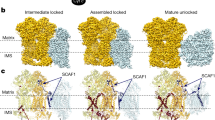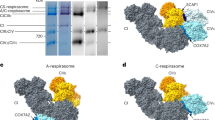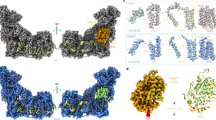Abstract
Cytochrome c oxidase (complex IV, CIV) is known in mammals to exist independently or in association with other respiratory proteins to form supercomplexes (SCs). In Saccharomyces cerevisiae, CIV is found solely in an SC with cytochrome bc1 (complex III, CIII). Here, we present the cryogenic electron microscopy (cryo-EM) structure of S. cerevisiae CIV in a III2IV2 SC at 3.3 Å resolution. While overall similarity to mammalian homologs is high, we found notable differences in the supernumerary subunits Cox26 and Cox13; the latter exhibits a unique arrangement that precludes CIV dimerization as seen in bovine. A conformational shift in the matrix domain of Cox5A—involved in allosteric inhibition by ATP—may arise from its association with CIII. The CIII–CIV arrangement highlights a conserved interaction interface of CIII, albeit one occupied by complex I in mammalian respirasomes. We discuss our findings in the context of the potential impact of SC formation on CIV regulation.
This is a preview of subscription content, access via your institution
Access options
Access Nature and 54 other Nature Portfolio journals
Get Nature+, our best-value online-access subscription
$29.99 / 30 days
cancel any time
Subscribe to this journal
Receive 12 print issues and online access
$189.00 per year
only $15.75 per issue
Buy this article
- Purchase on Springer Link
- Instant access to full article PDF
Prices may be subject to local taxes which are calculated during checkout





Similar content being viewed by others
Data availability
All relevant data are included in the manuscript and/or are available from the corresponding authors upon reasonable request. Cryo-EM maps have been deposited in the Electron Microscopy Data Bank (EMDB) under accession codes EMD-0262 (III2IV2 SC), EMD-0269 (CIVa) and EMD-0268 (CIVb). The coordinates of the atomic model of the III2IV2 SC built from a combination of the three maps have been deposited in PDB under accession code 6HU9.
References
Rich, P. R. & Maréchal, A. The mitochondrial respiratory chain. Essays Biochem. 47, 1–23 (2010).
Rich, P. R. Mitochondrial cytochrome c oxidase: catalysis, coupling and controversies. Biochem. Soc. Trans. 45, 813–29 (2017).
Pierron, D. et al. Cytochrome c oxidase: evolution of control via nuclear subunit addition. Biochim. Biophys. Acta 1817, 590–597 (2012).
Horvat, S., Beyer, C. & Arnold, S. Effect of hypoxia on the transcription pattern of subunit isoforms and the kinetics of cytochrome c oxidase in cortical astrocytes and cerebellar neurons. J. Neurochem. 99, 937–951 (2006).
Schägger, H. & Pfeiffer, K. Supercomplexes in the respiratory chains of yeast and mammalian mitochondria. EMBO J. 19, 1773–1783 (2000).
Davies, K. M., Blum, T. B. & Kühlbrandt, W. Conserved in situ arrangement of complex I and III2 in mitochondrial respiratory chain supercomplexes of mammals, yeast, and plants. Proc. Natl Acad. Sci. USA 115, 3024–3029 (2018).
Schägger, H. & Pfeiffer, K. The ratio of oxidative phosphorylation complexes I-V in bovine heart mitochondria and the composition of respiratory chain supercomplexes. J. Biol. Chem. 276, 37861–37867 (2001).
Acín-Pérez, R. et al. Respiratory active mitochondrial supercomplexes. Mol. Cell 32, 529–539 (2008).
Greggio, C. et al. Enhanced respiratory chain supercomplex formation in response to exercise in human skeletal muscle. Cell Metab. 25, 301–311 (2017).
McKenzie, M., Lazarou, M., Thorburn, D. R. & Ryan, M. T. Mitochondrial respiratory chain supercomplexes are destabilized in Barth Syndrome patients. J. Mol. Biol. 361, 462–469 (2006).
Letts, J. A., Fiedorczuk, K. & Sazanov, L. A. The architecture of respiratory supercomplexes. Nature 537, 644–648 (2016).
Gu, J. et al. The architecture of the mammalian respirasome. Nature 537, 639–643 (2016).
Guo, R. et al. Architecture of human mitochondrial respiratory megacomplex I2III2IV2. Cell 170, 1247–1257 (2017).
Lasserre, J. P. et al. Yeast as a system for modeling mitochondrial disease mechanisms and discovering therapies. Dis. Model Mech. 8, 509–526 (2015).
Tsukihara, T. et al. The whole structure of the 13-subunit oxidized cytochrome c oxidase at 2.8 Å. Science 272, 1136–1144 (1996).
Zong, S. et al. Structure of the intact 14-subunit human cytochrome c oxidase. Cell Res. 28, 1026–1034 (2018).
Heinemeyer, J., Braun, H.-P., Boekema, E. & Kouril, R. A structural model of the cytochrome c reductase/oxidase supercomplex from yeast mitochondria. J. Biol. Chem. 282, 12240–12248 (2007).
Mileykovskaya, E. et al. Arrangement of the respiratory chain complexes in Saccharomyces cerevisiae supercomplex III2IV2 revealed by single particle cryo-electron microscopy. J. Biol. Chem. 287, 23095–23103 (2012).
Sun, C. et al. Structure of the alternative complex III in a supercomplex with cytochrome oxidase. Nature 557, 123–126 (2018).
Bai, X. C. et al. Sampling the conformational space of the catalytic subunit of human ɣ-Secretase. eLife 4, e11182 (2015).
Geier, B. M. et al. Kinetic properties and ligand binding of the eleven subunit cytochrome c oxidase from Saccharomyces cerevisiae isolated with a novel large scale purification method. Eur. J. Biochem. 227, 296–302 (1995).
Maréchal, A. et al. Yeast cytochrome c oxidase: a model system to study mitochondrial forms of the haem-copper oxidase superfamily. Biochim. Biophys. Acta 1817, 620–628 (2012).
Levchenco, M. et al. Cox26 is a novel stoichiometric subunit of the yeast cytochrome c oxidase. Biochim. Biophys. Acta 1863, 1624–1632 (2016).
Strecker, V. et al. Supercomplex-associated Cox26 protein binds to cytochrome c oxidase. Biochim. Biophys. Acta 1863, 1643–1652 (2016).
Strogolova, V. et al. Rcf1 and Rcf2, members of the hypoxia-induced gene 1 protein family, are critical components of the mitochondrial cytochrome bc1–cytochrome c oxidase supercomplex. Mol. Cell. Biol. 32, 1363–1373 (2012).
Tsukihara, T. et al. The low-spin heme of cytochrome c oxidase as the driving element of the proton-pumping process. Proc. Natl Acad. Sci. USA 100, 15304–15309 (2003).
Burke, P. V. et al. Effects of oxygen concentration on the expression of cytochrome c and cytochrome c oxidase genes in yeast. J. Biol. Chem. 272, 14705–14712 (1997).
Maréchal, A., Iwaki, M. & Rich, P. R. Structural changes in cytochrome c oxidase induced by binding of sodium and calcium ions: an ATR-FTIR study. J. Am. Chem. Soc. 135, 5802–5807 (2013).
Rich, P. R. & Maréchal, A. Functions of the hydrophilic channels in protonmotive cytochrome c oxidase. J. R. Soc. Interface 10, 1–14 (2013).
Arnold, S. & Kadenbach, B. Cell respiration is controlled by ATP, an allosteric inhibitor of cytochrome c oxidase. Eur. J. Biochem. 249, 350–354 (1997).
Acín-Pérez, R., Gatti, D. L., Bai, Y. & Manfredi, G. Protein phosphorylation and preventation of cytochrome c oxidase inhibition by ATP: coupled mechanisms of energy metabolism regulation. Cell Metab. 13, 712–719 (2011).
Hess, K. C. et al. A mitochondrial CO2-adenylyl cyclase-cAMP signalosome controls yeast normoxic cytochrome c oxidase activity. FASEB J. 28, 4369–4380 (2014).
Hunte, C. et al. Structure at 2.3 Å resolution of the cytochrome bc1 complex from the yeast Saccharomyces cerevisiae co-crystallized with antibody Fv fragment. Structure 8, 669–684 (2000).
Zhang, Z. et al. Electron transfer by domain movement in cytochrome bc1. Nature 392, 677–684 (1998).
Brandt, U., Uribe, S., Schägger, H. & Trumpower, B. L. Isolation and characterization of QCR10, the nuclear gene encoding the 8.5-kDa subunit 10 of the Saccharomyces cerevisiae cytochrome bc1 complex. J. Biol. Chem. 269, 12947–12953 (1994).
Mileykovskaya, E. & Dowhan, W. Cardiolipin-dependent formation of mitochondrial respiratory supercomplexes. Chem. Phys. Lipids 179, 42–48 (2014).
Cogliati, S. et al. Mechanism of super-assembly of respiratory complexes III and IV. Nature 539, 579–582 (2016).
Milenkovic, D., Blaza, J. N., Larsson, N. G. & Hirst, J. The enigma of the respiratory chain supercomplex. Cell Metab. 25, 765–776 (2017).
Fedor, J. G. & Hirst, J. Mitochondrial supercomplexes do not enhance catalysis by quinone channeling. Cell Metab. 28, 525–531 (2018).
Letts, J. A. & Sazanov, L. A. Clarifying the supercomplex: the higher-order organization of the mitochondrial electron transport chain. Nat. Struct. Mol. Biol. 24, 800–808 (2017).
Allen, L. A., Zhao, X.-J., Caughey, W. & Poyton, R. O. Isoforms of yeast cytochrome c oxidase subunit V affect the binuclear reaction center and alter the kinetics of interaction with the isoforms of yeast cytochrome c . J. Biol. Chem. 270, 110–118 (1995).
Fukuda, R. et al. HIF-1 regulates cytochrome oxidase subunits to optimize efficiency of respiration in hypoxic cells. Cell 129, 111–122 (2007).
Meunier, B., Maréchal, A. & Rich, P. R. Construction of histidine-tagged yeast mitochondrial cytochrome c oxidase for facile purification of mutant forms. Biochem. J. 444, 199–204 (2012).
Dodia, R., Meunier, B., Kay, C. W. M. & Rich, P. R. Comparisons of subunit 5A and 5B isozymes of yeast cytochrome c oxidase. Biochem. J. 464, 335–342 (2014).
Schägger, H. Tricine-SDS-page. Nat. Protoc. 1, 16–22 (2006).
Heide, H. et al. Complexome profiling identifies TMEM126B as a component of the mitochondrial complex I assembly complex. Cell Metab. 16, 538–549 (2012).
Guerrero-Castillo, S., Cabrera-Orefice, A., Huynen, M. A. & Arnold, S. Identification and evolutionary analysis of tissue-specific isoforms of mitochondrial complex I subunit NDUFV3. Biochim. Biophys. Acta 1858, 208–217 (2017).
Zheng, S. Q. et al. MotionCor2: anisotropic correction of beam-induced motion for improved cryo-electron microscopy. Nat. Methods 14, 331–332 (2017).
Rohou, A. & Grigorieff, N. CTFFIND4: fast and accurate defocus estimation from electron micrographs. J. Struct. Biol. 192, 216–221 (2015).
Punjani, A., Rubinstein, J. L., Fleet, D. J. & Brubaker, M. A. CryoSPARC: algorithms for rapid unsupervised cryo-EM structure determination. Nat. Methods 14, 290–296 (2017).
Scheres, S. H. RELION: implementation of a Bayesian approach to cryo-EM structure determination. J. Struct. Biol. 180, 519–530 (2012).
Kucukelbir, A., Sigworth, F. J. & Tagare, H. D. Quantifying the local resolution of cryo-EM density maps. Nat. Methods 11, 63–65 (2014).
Pettersen, E. F. et al. UCSF Chimera—a visualization system for exploratory research and analysis. J. Comput. Chem. 25, 1605–1612 (2004).
Emsley, P., Lohkamp, B., Scott, W. G. & Cowtan, K. Features and development of Coot. Acta Crystallogr. D 66, 486–501 (2010).
Lange, C. & Hunte, C. Crystal structure of the yeast cytochrome bc 1 complex with its bound substrate cytochrome c. Proc. Natl Acad. Sci. USA 99, 2800–2805 (2002).
Adams, P. D. et al. PHENIX: a comprehensive Python-based system for macromolecular structure solution. Acta Crystallogr. D 66, 213–221 (2010).
Winn, M. D. et al. Overview of the CCP4 suite and current developments. Acta Crystallogr. D 67, 235–242 (2011).
Acknowledgements
We would like to thank Diamond Light Source for access and support to the cryo-EM facilities at the UK National Electron Bio-Imaging Centre (eBIC, proposal no. EM14704-36) funded by the Wellcome Trust, the Medical Research Council, UK and the Biotechnology and Biological Sciences Research Council. We would also like to thank D. Houldershaw and the computer support group at Birkbeck. This work was supported by the Medical Research Council (Career Development Award no. MR/M00936X/1 to A.M.), the Birkbeck Wellcome Trust Institutional Strategic Support Fund (grant no. 105628/Z/14/Z to A.M.) and a Wellcome Trust grant to the Birkbeck EM facility (no. 079605/2/06/2).
Author information
Authors and Affiliations
Contributions
A.M. designed and supervised the research. B.M. produced the yeast mutant strain. A.M.H. did all the protein work with contribution from Y.Z. A.C.-O. and S.A. performed mass spectrometry analysis. N.L. and A.M.H. performed all microscopy work. A.M.H. and N.P. processed the cryo-EM images. N.P. built the model with inputs from A.M. and A.M.H. A.M., A.M.H. and N.P. wrote the manuscript with contributions from all authors.
Corresponding authors
Ethics declarations
Competing interests
The authors declare no competing interests.
Additional information
Publisher’s note: Springer Nature remains neutral with regard to jurisdictional claims in published maps and institutional affiliations.
Integrated supplementary information
Supplementary Figure 1 Biochemical characterization of S. cerevisiae III2IV2 SC.
a, UV-visible redox spectrum of the purified yeast III2IV2 SC. Peaks are labeled and correspond to the A-type hemes present in CIV (445/604 nm) and the B- and C-type hemes present in CIII (432/562 nm and 554 nm). b, Gel filtration profile of the yeast III2IV2 SC. The fraction eluting between 12 and 12.5 mL was used for cryo-EM. c, BN-PAGE gel of the purified yeast III2IV2 SC. d, Oxygen consumption rate of the III2IV2 SC (red line) in the presence of 50 μM cytochrome c, initiated by addition of 40 μM decylubiquinol (decylUQH2). A baseline (green) is recorded after addition of 1 mM KCN, an inhibitor of CIV. e, Oxygen consumption rate of the III2IV2 SC without exogenous cytochrome c (experiment details are as in d). Data in a–c are representative of three independent experiments with similar results.
Supplementary Figure 2 Cryo-EM data collection and workflow of 3D classification and focused refinement.
a, A representative cryo-EM micrograph of III2IV2 SC (scale bar, 30 nm). b, Representative 2D class averages of the III2IV2 SC (scale bar, 20 nm). c, Fourier shell correlation (FSC) curves between two independently refined half-maps for the III2IV2 SC map and for the two CIV maps, each individually refined. d, Surface rendering maps colored according to local resolution. Upper and middle panels present the maps of the III2IV2 SC and CIVa and CIVb after focused refinement. The lower display shows the central sections of the two CIV maps to emphasize further the improvement in resolution (scale bar, 50 Å). e, Euler angle distributions of the 44,915 particles included in the calculation of the III2IV2 SC map for two orientations rotated by 90 degrees. Data collection and structure calculation are not repeated.
Supplementary Figure 3 Fitting of the CIV model into the cryo-EM density.
a, Fitting of cofactors, metal clusters and identified lipids into the CIVa cryo-EM map density. Below each model are the names of the cofactor/metal/lipid, alongside the domain and chain as in PDB 6HU9 they belong to. The numbering refers to residues found nearby or providing coordination (PEF, palmitoyl-phosphatidylethanolamine; PCF, diacyl-glycero-phosphocholine). b, Two examples of high-resolution α-helical regions of CIV, Cox5A which forms the interface with CIII and the core domain Cox1. c, Fitting of a β-sheet from Cox2. d, Fitting of the distal subunit Cox13 (chain k) and the new subunit Cox26 (chain l) into the density. The N and C termini of the chains are indicated. The corresponding cofactors, metals, lipids and subunits from the other CIV monomer (CIVb) display identical density (data not shown).
Supplementary Figure 4 Fitting of the CIII model into the cryo-EM density.
a, Fitting of cofactors, metal clusters and identified lipids into the III2IV2 SC cryo-EM map density. Below each model are the names of the cofactor/metal/lipid, alongside the domain and chain as in PDB 6HU9 they belong to. The numbering refers to residues found nearby or providing coordination (PEF, palmitoyl-phosphatidylethanolamine; PCF, diacyl-glycero-phosphocholine). b, Fitting of the subunits Rip1 (chain E) and Qcr10 (chain J) into the density. The N and C termini of the chains are indicated. Note the lower resolution of the flexible C-terminal catalytic domain of Rip1 (zoom in). This domain, as well as Qcr10, displays higher B factors compared to the other subunits of CIII (data not shown). The corresponding domains from the second monomer of CIII display identical density (data not shown).
Supplementary Figure 5 Structural alignment of the two halves of the III2IV2 SC.
a,b, Side (a) and top (b) views of a structural alignment of the two halves of the III2IV2 SC, aligned on their core CIII subunits, Cor1, Cor2 and cytochrome b. This reveals minimal deviation of Cox5A at the SC interface (~0.3–0.5 Å), but a larger deviation of Cox13 (3.0 Å), at the extreme periphery of the SC. Cox26 and Qcr10 are displayed in green and red, respectively.
Supplementary Figure 6 Position of COX7B would not preclude interactions via COX4-1 in a mammalian CIII–CIV SC.
a,b, Side (a) and top (b) view of a putative mammalian III2IV1 SC formed after substitution of the yeast CIV monomer (CIVa) with bovine CIV (PDB 1V54) as per our III2IV2 SC structure (the other CIV is not shown). COX7B (blue), a subunit of mammalian CIV, lies near COX4-1 (pale cyan; the homolog of yeast Cox5A). However, it would not interfere with any interactions between CIII and COX4-1, such as those seen in the yeast III2IV2 SC structure. COX7A (deep red), the subunit involved in interactions with CIII in the mammalian I1III2IV1 respirasome, is also highlighted.
Supplementary information
Supplementary Text and Figures
Supplementary Figures 1–6 and Supplementary Table 1
Rights and permissions
About this article
Cite this article
Hartley, A.M., Lukoyanova, N., Zhang, Y. et al. Structure of yeast cytochrome c oxidase in a supercomplex with cytochrome bc1. Nat Struct Mol Biol 26, 78–83 (2019). https://doi.org/10.1038/s41594-018-0172-z
Received:
Accepted:
Published:
Issue Date:
DOI: https://doi.org/10.1038/s41594-018-0172-z
This article is cited by
-
Structures of Tetrahymena thermophila respiratory megacomplexes on the tubular mitochondrial cristae
Nature Communications (2023)
-
Cryo-EM structure and function of S. pombe complex IV with bound respiratory supercomplex factor
Communications Chemistry (2023)
-
Structural insights into cardiolipin replacement by phosphatidylglycerol in a cardiolipin-lacking yeast respiratory supercomplex
Nature Communications (2023)
-
The assembly, regulation and function of the mitochondrial respiratory chain
Nature Reviews Molecular Cell Biology (2022)
-
NMR structural analysis of the yeast cytochrome c oxidase subunit Cox13 and its interaction with ATP
BMC Biology (2021)



